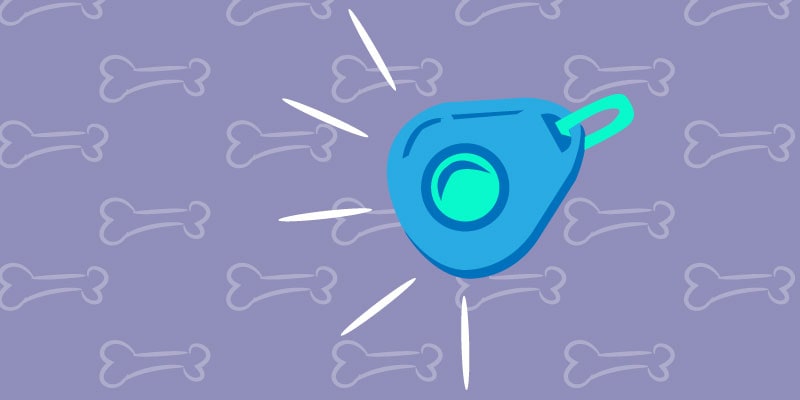Reward-Based clicker training is a quick and easy way to teach your dog not just tricks, but positive behaviours that will help keep your pooch safe when out and about on adventures.

Whether you’ve got a new puppy or are looking for a better way to train a stubborn pooch, you might want to consider clicker training your dog.
Click Training may feel like an additional step (surely treats works just as well on their own?) but there are a few reasons Clickers are such a popular way to train dogs.
- It helps dogs learn the behaviour you want from them faster
- Eventually, you won’t even need treats or rewards, the clicker will become its own reward
- Fewer treats mean less chance of weight issues later down the line
Interested? Read on.
How does Dog Clicker Training work?
Clicker Training works by teaching your dog to associate the sound of the click with an instant reward. At heart, that’s all it is: they hear the click, they get food. It creates a happy positive connotation to the sound.
The trick to training is then using the clicker to tell your dog that they have done the things you want them to do: sit, stay, down, etc…
Why use the clicker when you can use your voice?
From the moment your dog does the desired behaviour to the moment you give him a treat or reward, there is usually a lag.
For example, you tell a puppy to sit. It sits. You say well done, get the treat out, and his bum is off the floor in excitement for the treat. In his mind, there might be confusion as to whether he is getting the treat for sitting or for standing up in excitement.
With a click, you remove that doubt. The moment that bum hits the floor: click. Then reward. Bum on the floor again on command? Click. Reward.
In short, clicker training a dog is a faster and clearer way to get the results you want. They know exactly what behaviour got the click, and (as a result) the much-desired treat.
Eventually, the click is the reward itself. A noisy “well done” each time they do as you say.
How to Clicker Train Dogs in 5 easy steps:
With clicker training, timing is everything. As soon as a click is heard, a treat must be rewarded. Once they understand that, you need to associate the click with the desired behaviour.
Even if your dog already knows simple tricks, reteach the simple tricks with the clicker train methods to get them used to the idea.
1. Click = Reward
The first step is the easiest step. Go somewhere quiet and away from distractions, with your dog, the clicker and their favourite treats.
If your dog is not food-led, find a high-level treat – this could be as simple as small pieces of cooked chicken if normal dog treats won’t do. They need to view the clicker as giving away worthy rewards
Don’t take the clicker out and point it at your dog, instead put it by your side and get to your dog’s level. Then simply click and feed a treat. The rewards need to follow as soon as possible after the click.
If they are doing something you want to discourage (barking, pawing) don’t click. Wait for them to be calm again, and then start again.
Do this for about 2 to 5 minutes a few times a day. You want to get to the point where as soon as they hear the click they look at you expecting a reward.
2. Click = “Good Boy! That’s what I want!”
Now for basic dog training. Even if your dog knows how to sit or paw, it makes it easier for you to teach them that a click means they got it right.
But let’s pretend this is a total puppy, so let’s start with something simple like ‘sit’.
- Hold a treat or toy up in your hand.
- Move it up and slowly start moving it as if going over your dogs head
- They should automatically sit back
- Click as soon as they sit
- Immediately give them a treat
Repeat multiple times until they get that the click is associated with sitting.
3. Add a voice command
Once your puppy is easily sitting with the lure of the toy or treat, add a voice command.
In other words, as soon as their bum hits the floor, say “sit”, click and reward.
You’ll probably need to repeat this a few times before they get it, but once they seem comfortable. Try and remove the lure and just use the voice command.
4. Keep sessions short
You want training to be a happy and fun experience for everyone, especially your dog.
If your dog is a puppy keep the training sessions to 10 or 15 minutes at a maximum, less if your puppy is particularly young.
If your dog is older, energetic, or comes from a working dog breed (Spaniels, Collies, Shepherds, etc…) you can probably do slightly longer sessions.
But if your dog starts to get annoyed, distracted or you get frustrated, stop and try again later. There’s no right or wrong, sometimes it’s fine to go back a couple of steps and start again.
5. Start reducing the treats
If everything goes well, your dog will soon recognise what ‘sit’ means, and that when they do the behaviour asked, they get a click and a reward.
Once they do the trick confidently and happily, you can start reducing the frequency of the treats to click. Maybe only give a click every other time, and then slowly faze it out.
The click will have such a happy and good connection to the dog, that the click becomes the reward.
Of course, if you want to train them to do a new trick, you’ll have to bring back the high-reward treats and start from step 2.
The Dos and Don’t of Click Training Dogs
- DO give a reward at every click. Clicked accidentally? Give a treat. They need to make that association early.
- DON’T use the clicker for recall or to get their attention. The click is the equivalent of “well done for doing what I want”. If you try and turn it into a “look at me” or “come to me” it will confuse the dog and lose its effectiveness.
- DO keep your training sessions short and fun. 10-15 minutes max.
- DON’T click more than once. One-click per good behaviour.
- DO click exactly as your dog does the right behaviour. Don’t lag or click too late. Better to not click at all if you miss your moment.
- DON’T get frustrated if your dog doesn’t get it at once or suddenly doesn’t ‘get’ it. Go back to an easier step and practice that step for longer and then move on. It can take time.
Once you get through step 1, make sure you carry the clicker with you for when you need to get the behaviour you want from your dog.
Use a clicker that you can strap onto your wrist and is quick to bring out. Consistency is key. You will not always need a clicker – if you are out camping with your dog it may not be easy to always have it at hand.
But remember that the point of the clicker is to get the dog to learn the behaviours faster and to replace treats as a reward. Once they get the voice command, you can use the command as necessary even without a clicker.







